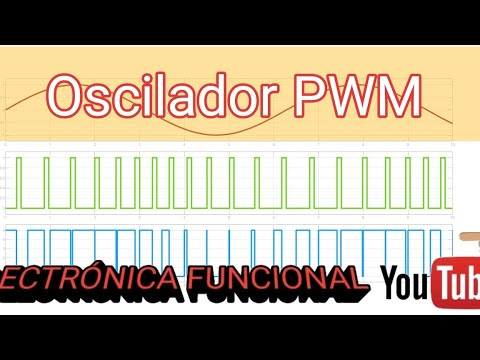Practical applications of PWM in modern electronics
Hello all electronics lovers! Today I come to talk to you about one of the most exciting and useful topics in the world of modern electronics: PWM. Yes, yes, I know it may sound a bit technical and boring, but don't worry, I will explain to you in a simple and entertaining way everything you need to know about it. Can you imagine being able to regulate the speed of a motor, the intensity of a light or the sound of a speaker with just a few electrical pulses? Well, that is precisely what PWM allows us to do! So, if you want to know all the practical applications of this technique in the world of electronics, don't miss this article!
Optimize the performance of your electronic circuits with the PWM technique
Optimize the performance of your electronic circuits with the PWM technique
PWM (Pulse Width Modulation) is a technique used in electronics to control the amount of power sent to a device. This technique is based on varying the width of a digital signal pulse, which is used to control the amount of energy sent to a device in a given period of time.
The PWM technique is widely used in modern electronics to control motors, LED lights, power supplies, among other devices. Next, we will see some practical applications of the PWM technique in modern electronics:
- Motor control: The PWM technique is used to control the speed of electric motors. By varying the width of the signal pulses sent to the motor, you can control the amount of power sent to the motor and therefore the speed of the motor. This technique is used in robots, drones, electric vehicles, among other equipment.
- LED lights control: The PWM technique is used to control the intensity of light emitted by LEDs. By varying the width of the signal pulses sent to the LEDs, you can control the amount of energy sent to them and, therefore, the intensity of the light they emit. This technique is used in indoor and outdoor lighting, LED screens, among other equipment.
- Control of power supplies: The PWM technique is used to control the output of power supplies. By varying the width of the signal pulses sent to the power supply, you can control the amount of power sent to the load and therefore the output of the power supply. This technique is used in computers, mobile devices, audio systems, among other equipment.
The PWM technique offers several advantages in modern electronics, including:
- Greater energy efficiency: By controlling the amount of power sent to devices, you can reduce power consumption and therefore improve the energy efficiency of your equipment.
- Greater precision: By controlling the amount of power sent to devices, greater precision in device control can be achieved.
- Greater Durability: By controlling the amount of power sent to devices, you can reduce wear and tear on them and therefore improve their durability.
In summary, the PWM technique is a very useful technique in modern electronics that allows you to control the amount of power sent to devices efficiently and precisely. This technique is used in a wide variety of applications, from controlling motors and LED lights to controlling power supplies. If you want to optimize the performance of your electronic circuits, try the PWM technique!
Optimize the performance of your car with the PWM technique in electronic systems
The PWM (Pulse Width Modulation) technique is a technique used in electronics to control the amount of energy sent to a device by manipulating the frequency and width of electrical pulses. In the automotive field, this technique can be used to optimize the performance of a car in various aspects, such as fuel consumption, the emission of polluting gases and engine power. Below are some practical applications of PWM in modern electronics to improve the performance of a car.
- Fuel pump control: The fuel pump is one of the most important components of a car's fuel system. PWM can be used to control the speed of the fuel pump, allowing the amount of fuel sent to the engine to be adjusted. This helps improve fuel efficiency and reduce polluting gas emissions.
- Fuel injection system control: The fuel injection system is another key component of a car's fuel system. PWM can be used to control the amount of fuel injected into the engine, helping to improve fuel efficiency and reduce polluting gas emissions.
- Radiator fan control: The radiator fan is another important component of a car as it helps keep the engine temperature at optimal levels. PWM can be used to control the speed of the radiator fan, allowing you to adjust the amount of air being sent to the radiator. This helps improve fuel efficiency and reduce polluting gas emissions.
- Engine speed control: PWM can be used to control the speed of a car's engine, allowing the amount of power sent to the engine to be adjusted. This helps improve fuel efficiency and reduce polluting gas emissions.
In summary, the PWM technique can be used in many aspects of modern electronics to improve the performance of a car. By controlling the amount of energy sent to devices, you can improve fuel efficiency and reduce polluting gas emissions. Additionally, PWM can also be used to control the speed of the engine and radiator fan, helping to maintain engine temperatures at optimal levels.
The key behind electronic speed regulation: PWM
The key behind electronic speed regulation: PWM
PWM (Pulse Width Modulation) is a signal modulation technique used to control the amount of power supplied to an electrical device. This technique is widely used in modern electronics to control the speed of motors, regulate the power of LED lighting, among others.
Below are some practical applications of PWM in modern electronics:
- Motor speed control: PWM is used to control the speed of motors. By varying the pulse width of the PWM signal, you can control the amount of power supplied to the motor, which in turn controls its speed. For example, in computer fans, PWM is used to control fan speed and reduce system noise.
- LED lighting power regulation: PWM is used to control the power of LED lighting. By varying the pulse width of the PWM signal, you can control the amount of power supplied to the LEDs, which in turn controls their brightness. For example, in automotive LED lighting systems, PWM is used to control the brightness of brake lights and turn signal lights.
- Temperature control: PWM is used to control the temperature of electronic devices. By varying the pulse width of the PWM signal, you can control the amount of power supplied to the device, which in turn controls its temperature. For example, in computer cooling systems, PWM is used to control fan speed and keep system temperatures within safe limits.
- Audio Power Control: PWM is used to control the power of audio amplifiers. By varying the pulse width of the PWM signal, you can control the amount of power supplied to the amplifier, which in turn controls the audio output power. For example, in car audio systems, PWM is used to control the power of amplifiers and prevent audio distortion.
Optimize efficiency in industry with PWM pulse width modulation
Pulse width modulation (PWM) is a technique used in electronics to control the amount of power supplied to an electrical device. This technique is especially useful in industry, where the aim is to optimize efficiency and reduce energy costs. Below are some of the practical applications of PWM in modern electronics:
- Motor speed control: PWM is used to control the speed of electric motors as it allows the amount of power supplied to the motor to be adjusted. This is useful in industry, where a constant and precise speed is needed to perform certain tasks.
- LED lights brightness control: LED lights can also be controlled via PWM, allowing you to adjust the intensity of the light emitted. This is used in the lighting industry to create visual effects and to save energy.
- Temperature control: PWM can be used to control the temperature of a system by allowing you to adjust the amount of power supplied to the heating elements. This is useful in the food industry, where certain temperatures need to be maintained to ensure food safety and quality.
- sound control: PWM is also used to control sound in audio systems, as it allows you to adjust the amount of power supplied to the speakers. This is used in the music and entertainment industry to create sound effects and to ensure optimal sound quality.
In summary, pulse width modulation is a very useful technique in industry to optimize efficiency and reduce energy costs. It is used in a wide variety of applications, from motor speed control to sound control in audio systems. If you want to know more about this technique and its practical applications, consult the following table:
| Application | Description |
|---|---|
| Motor speed control | It allows you to adjust the amount of energy supplied to an electric motor to control its speed. |
| LED light brightness control | Allows you to adjust the intensity of the light emitted by LED lights to create visual effects and save energy. |
| Temperature control | Allows you to adjust the amount of energy supplied to heating elements to control the temperature of a system. |
| Sound control | Allows you to adjust the amount of power supplied to the speakers to control the sound in audio systems. |
Explore the different types of PWM in modern electronics
PWM (Pulse Width Modulation) is a technique used in electronics to control the amount of power supplied to a device or component. This technique is especially useful in controlling electric motors and regulating the brightness of LED screens.
There are different types of PWM used in modern electronics, each with its own characteristics and practical applications. Some of them are:
- Conventional PWM: It is the simplest type of PWM and is used in applications where high frequency signal modulation is required. This type of PWM is suitable for controlling the speed of motors, the brightness of LED screens, among others.
- Phase PWM: This type of PWM is used to control the speed and direction of alternating current (AC) electric motors. It is also used in lighting applications.
- PWM current: This type of PWM is used to control the current flowing through a device or component. It is especially useful in applications where precise current regulation is required, such as in stepper motors and power electronics.
- Variable frequency PWM: This type of PWM is used to control the frequency of the PWM signal. It is useful in applications where low frequency signal modulation is required.
| PWM type | Practical applications |
|---|---|
| conventional PWM | Motor speed control, brightness regulation on LED screens |
| Phase PWM | Speed and direction control of alternating current (AC) electric motors, lighting applications |
| PWM current | Precise current regulation in stepper motors and power electronics |
| Variable frequency PWM | Modulation of low frequency signals |
In summary, the use of different types of PWM is essential in modern electronics to control the amount of energy supplied to devices and components, allowing precise and efficient regulation of them in different practical applications.
In summary, PWM is a very useful technique in modern electronics that allows us to control the power of our devices in an efficient and precise way. From controlling motors to dimming light in LED displays, PWM has practical applications in many fields of electronics. So don't hesitate to explore all the possibilities that this technique offers you and put your electronics knowledge into practice!



Post Comment